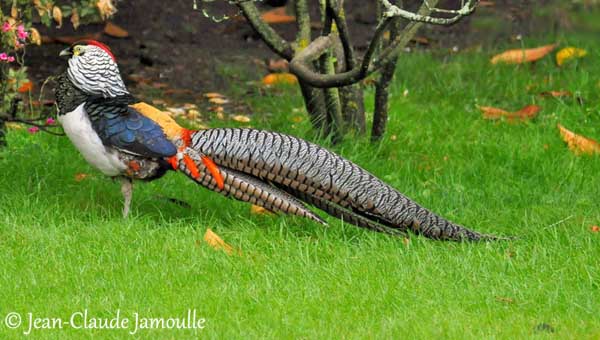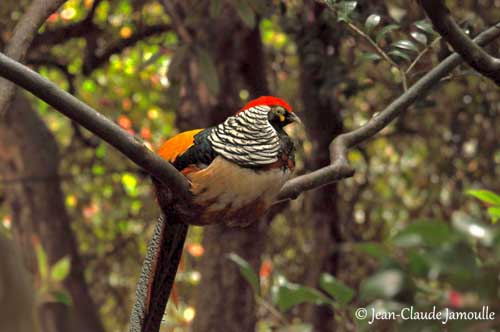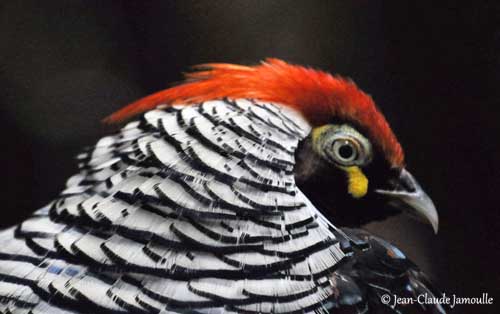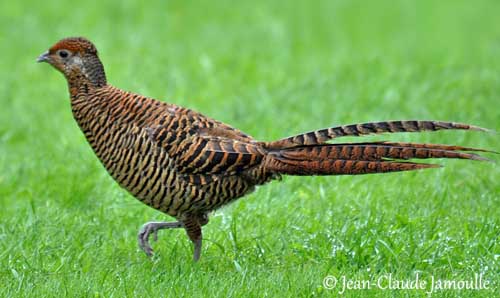
Fr: Faisan de Lady Amherst
All : Diamantfasan
Esp: Faisán de Lady Amherst
Ital: Fagiano di Lady Amherst
Nd: Lady-Amherstfazant
Sd: Diamantfasan
Photographer:
Jean-Claude Jamoulle
A la rencontre des Oiseaux
Text by Nicole Bouglouan
Sources:
HANDBOOK OF THE BIRDS OF THE WORLD Vol 2 by Josep del Hoyo-Andrew Elliot-Jordi Sargatal - Lynx Edicions - ISBN: 8487334156
L’ENCYCLOPEDIE MONDIALE DES OISEAUX - Dr Christopher M. Perrins - BORDAS - ISBN: 2040185607
A Field Guide to the Birds of South-East Asia by Craig Robson. New Holland Publishers. ISBN: 9781780090498
Hennache, A. & Ottaviani, M. (2005). Monographie des faisans, volume 1. Edition W.P.A. France, Clères, France. ISBN: 2-9512467-1-4
Hennache, A. & Ottaviani, M. (2006). Monographie des faisans, volume 2. Edition W.P.A. France, Clères, France.ISBN: 2-9512467-2-2
Les auteurs renoncent à leurs droits d'auteurs pour que la vente de cet ouvrage, publié par la World Pheasant Association, soit destinée à soutenir des projets de conservation.
BirdLife International (BirdLife International)
Gbwf.org - Dedicated to the Aviculture and Conservation of the World’s Galliformes
Wikipedia, the free encyclopaedia
Lady Amherst’s Pheasant
Chrysolophus amherstiae
Galliforme Order – Phasianidae Family
BIOMETRICS:
Male: L: 130-173 cm including the tail: 83-115 cm - Weight: 675-850 g
Female: L: 66-68 cm – Weight: 624-800g
Wingspan: 70-85 cm
DESCRIPTION:
The Lady Amherst’s Pheasant is found in SW China and Myanmar. The first specimen was sent to London UK in 1828, by Sarah Countess Amherst, wife of the Governor General of Bengal.
The adult male has dark bluish-green mantle, back, scapulars and breast with black scales. The uppertail-coverts are black-and-white, mixed with orange and red. The longer feathers show long, pointed orange tips. The rump is buffy-yellow and barred bluish-green. The long, arched, pointed tail is white with black bars and vermiculations. Throat and foreneck are blackish. The belly is white whereas vent and undertail-coverts are white barred black.
On the head, face, chin and forecrown are dark bluish-green. On the hindcrown, there is a bright red crest ending to a point on the nape. A superb black-scaled neck-ruff adds an indisputable touch of class to the bird’s appearance.
The bill is pale bluish-grey. The eyes are white, surrounded by broad, bare, pale blue eyering. We can see a small yellowish wattle under the eye. Legs and feet are pale blue, with spurs in male.

The female has rich rufous-brown plumage, heavily barred black overall. The underparts are usually paler than upperparts.
On the head, the crown is more reddish, but the nape is dark grey. The tail is similar in colour to body plumage, but it is much shorter than in male. The eyes are brown with dull grey eyering.
The immature resembles female but it is paler and barring is less conspicuous. The young male starts to get the adult plumage from the first autumn.
VOICE: SOUNDS BY XENO-CANTO
The Lady Amherst’s Pheasant male gives loud, hoarse, slightly metallic and grating “hirk hik-ik” at territorial call. This sound is repeated at lengthy intervals, and interspersed with 1-3 rapid “kwik” notes. Males call from trees in the early morning.
HABITAT:
The Lady Amherst’s Pheasant occurs in forested areas and wooded hills, bamboo thickets, dense shrubby areas and secondary growths.
This species is visible between 2100 and 3600 metres of elevation.
RANGE:
The Lady Amherst’s Pheasant is found first in SW China and N Burma. But it can be uncommon resident in Extreme S Thailand and Malay Peninsula.
The species has been introduced in Great Britain where small numbers inhabit, and mainly in Bedfordshire.
BEHAVIOUR:
The Lady Amherst’s Pheasant is a very shy species, rarely seen outside the vegetal cover, spiny bushes or bamboo thickets. It lives in remote areas in mountains.

This species feeds mainly on bamboo sprouts in the original range. But it also takes spiders and small Coleopterans and also fern fronds. The chicks feed on several fruit species such as Rubus, Coria sinica and Vaccinium spregelii. They feed on the ground.
The breeding behaviour of this species is poorly known. However, the beautiful male’s adornments, and especially the neck-ruff, are fully expanded during the displays, forming a semi-circle of feathers around and below the eyes. The small wattle visible under the eye is also expanded until covering the lower cheek. The red crest is raised too.
The long tail of at least 100 cm long follows the movements of the cock during the displays. The bright orange uppertail-coverts are enhanced while the male is strutting.
Frontal and/or lateral displays in front of the female are performed by the male, in order to expose the colours and pattern of its plumage by moving wings and tail, and raising the neck-ruff.
As polygamous cocks, the males of this species perform elaborated and repeated displays.

The Lady Amherst’s Pheasant usually performs some altitudinal movements after the breeding season, reaching the foothills during hard weather.
FLIGHT:
The Lady Amherst’s Pheasant, like most Phasianidae species, prefers to escape a danger by running rather than flying. However, it may dart very quickly. When moving the wings by short, fast wingbeats, it is able to rise above the ground.
REPRODUCTION:
The laying starts at mid-April in S China and the male is territorial as soon as mid-March.
The nest of the Lady Amherst’s Pheasant is on the ground, usually under bush or dead branches. This is a round, shallow depression lined with dead leaves.
The hen lays 6-12 creamy-buff eggs. She incubates alone during 24 days. The chicks are precocial and leave the nest very soon. They are able to feed themselves, following the female which leads them to food sources and does not back to the nest again.
The chicks are covered in fulvous-brown down with paler bands above, and buffy-white below.

DIET:
The Lady Amherst’s Pheasant feeds usually on the ground, taking spiders and small Coleopterans. It also takes plant matter such as fern fronds, but its preferred food is mainly bamboo sprouts. It may consume seeds, roots and berries too.
PROTECTION / THREATS / STATUS:
The Lady Amherst’s Pheasant appears widespread throughout its range, but this pheasant is very shy and difficult to see.
However, the species is not currently threatened, and evaluated as Least Concern by BirdLife International.
Both pictures show the result of hybridization between this species and the Golden Pheasant, also present at this location.
The buffy-white breast is a good feature of hybridization.